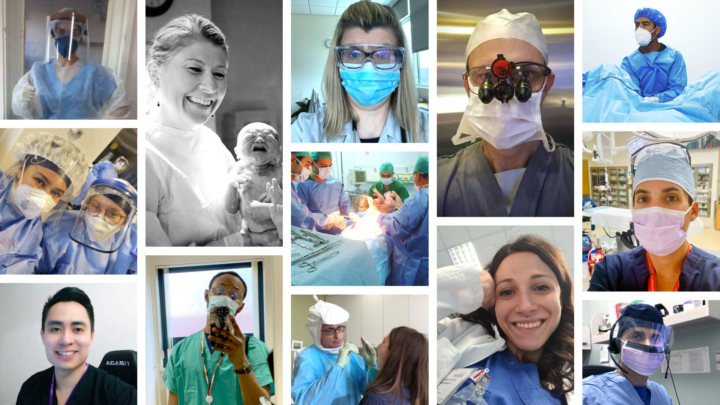
When choosing a specialty, medical students and doctors seeking a career change have many things to consider. Earning potential is one key consideration. Many doctors on Sermo emphasize that while they are driven by their passion, long-term well-being also requires fair compensation as well as a supportive working environment.
An OBGYN on Sermo advises to “Choose a specialty that you are still interested in even at 3AM. Remember that medicine can be a big part of your life though not your whole life. Pick a supportive practice with good ancillary support. Donʼt forget to rest your body and mind when you can,ˮ while a Sermo member and GP says, “In my case, I would choose medicine again because of the satisfaction it produces on an intellectual level and the motivation to help patients despite the adverse environment in which we practice.ˮ
In other words, most doctors on Sermo want a balance of good working conditions, fair pay, and the ability to pursue their passion. Some are turning to unionization or alternative practice models to improve compensation and conditions, while others remain cautious about systemic change. Understanding salary differences across specialties helps doctors make informed choices that align with both their professional goals and personal needs, as it can be tough to negotiate a favorable contract.
Average salary for doctors
A survey of US-based physicians on Sermo showed that while 78% of doctors did choose a medical career primarily based on passion, 46% considered work-life balance and 29% cited expected compensation as a factor. Of the surveyed physicians on Sermo, only 36% considered their compensation to be fair, and 50% were not satisfied with their current level of compensation.
According to one GP on Sermo, “Medical salaries are getting worse and the limitation on consultation time increases, this causes the quality of health services to deteriorate and generates burnout in professionals.ˮ This aligns with evidence that insufficient reward, including low compensation, is a significant predictor of burnout in physicians.
Despite these challenges, 63% of physicians would either definitely or probably pursue medicine if they could do it all over again, showcasing that love of their profession continues to drive career decisions.
Factors such as demographics, specialty, and cost of living all impact physician demand, and therefore, compensation. The average salary for doctors in the U.S. varies by specialty and location, with the median falling around $240,000 per year. Primary care physicians are on the lower end of the scale, while specialists tend to earn more. Doctors may seek to increase their earnings through lifestyle changes such as taking on locum tenens work, engaging in side hustles, or considering relocation to higher-paying regions, although location-based salary differences often reflect differences in cost of living.
What physician specialties make the most money?
So, which physician specialties pay the most? Medical students and physician peers benefit from understanding what pays well and what doesn’t, even if passion is still the driving force. Below are five of the highest-paid medical specialties in the United States, based on recent compensation reports.
Neurosurgery
Brain surgeon jokes aside, neurosurgeons command the highest pay of any specialty in the United States, often taking home well over $700,000 a year. However, they do pay a price for this: neurosurgeons have one of the longest training paths, typically spending 7 to 8 years as a resident learning the skills they need for such delicate work. High compensation for this specialty reflects the field’s intense demands and responsibility.
Orthopedic Surgery
Another specialty that requires extensive training is orthopedic surgeons, who diagnose and treat musculoskeletal conditions and can be paid over $500,000 per year.
This is not just because it’s a challenging specialty to learn, but also due to demand. With an aging population, knee and hip replacement needs continue to increase. The number of Americans 65 and older is projected to increase to 82 million by 2050, with a 23% share of the population. This underscores the growing need for physicians in this specialty.
Thoracic Surgery
Thoracic surgeons perform complex procedures affecting the heart, lungs, diaphragm, and chest wall. An aging population has increased demand for this specialty too, as thoracic surgeons treat heart failure, install pacemakers, perform coronary bypass, and many other procedures often related to aging bodies.
Plastic Surgery
Cosmetic surgeons are paid well in part because they perform elective procedures, such as breast augmentations, for which they can charge more. Compensation is driven by a combination of elective cosmetic procedures and complex reconstructive surgeries, such as post-trauma or cancer reconstruction. While cosmetic surgeries contribute significantly to earnings, the specialty plays a critical role in restoring function and appearance following injury or disease.

Cardiology
Cardiology is another specialty heavily impacted by an aging population. Cardiologists manage heart conditions through a wide range of interventions, from non-invasive treatments like medication and lifestyle counseling to procedures such as angioplasty and pacemaker insertion. Cardiovascular disease remains highly prevalent with almost half the U.S. population being affected, making this another specialty that can earn over half a million a year.
What are the least-paid physician specialties?
While medicine is often associated with high earning potential, not all specialties offer the same level of financial compensation. Unfortunately, several fields, despite being essential to patient care, consistently fall on the lower end of the scale. Knowing which specialties earn less can help provide a fuller picture of physician compensation.
Family medicine
Despite a projected shortage of primary care physicians, family medicine physicians tend to earn less than most specialists, despite playing a central role in patient care. Compensation is typically lower due to a shorter training path and broader scope of care, which may be perceived as less specialized. However, family doctors often manage a wide range of conditions and serve as the first point of contact in the healthcare system. In some settings, income potential can be improved by running an efficient practice or offering additional services.
Emergency medicine
Emergency medicine physicians work in high-pressure environments and often face long hours, unpredictable schedules, and emotionally demanding cases. Despite these challenges, average compensation for emergency medicine remains lower than some might expect—contributing to staffing shortages and burnout. On the positive side, EM physicians are in demand nationwide, which can offer geographic flexibility and negotiating power when choosing where to practice.
Infectious disease (ID)
Infectious disease specialists typically earn less than many other specialties, with average salaries often below $300,000. Despite their critical role especially evident during the COVID-19 pandemic, much of their work involves complex diagnostic reasoning, inpatient consultations, and long-term patient management, which are less financially rewarded than high-volume or surgical specialties. Additionally, many ID physicians work in academic or public health settings where salaries tend to be lower. This combination of factors contributes to fewer trainees entering the field, despite its growing importance in global health.
Public health and preventive care
Physicians specializing in public health and preventive medicine often earn some of the lowest salaries in the medical field. This is largely because their work focuses on population-level health, lifestyle medicine, and policy development rather than direct, billable patient care. Many public health doctors work for government agencies, academic institutions, or nonprofit organizations, where compensation structures are less lucrative than those in private clinical practice. Despite their vital role in addressing health disparities, managing outbreaks, and improving long-term health outcomes, the field tends to attract fewer physicians due to its lower earning potential and limited financial incentives.
Pediatrics
Pediatric care is often reimbursed at lower rates partly due to the perception that treating children is less complex than adult medicine. Additionally, many pediatricians work in primary care settings, where visit volume is high but compensation tends to be lower than in procedural or surgical specialties. Pediatricians also spend significant time on tasks not directly reimbursed, such as coordinating care with schools and social services or counseling parents. The result is a specialty driven more by passion and dedication to children’s health than financial incentives.
Average physician salary by specialty
Physician salaries are highly variable and influenced by region, experience, sub-specialty, and type of practice. The ranges and averages below are based on the most current publicly available data. These figures should be regarded as approximations, not guarantees of individual compensation.
| Specialty | Salary Range – Yearly |
| Neurosurgery | $700,000 – $800,000 |
| Thoracic Surgery | $650,000 – $800,000 |
| Orthopedic Surgery | $550,000 – $680,000 |
| Plastic Surgery | $550,000 – $650,000 |
| Urology | $500,000 – $550,000 |
| Cardiology | $480,000 – $620,000 |
| Radiology | $500,000 – $550,000 |
| Dermatology | $470,000 – $540,000 |
| Otolaryngology (ENT) | $460,000 – $500,000 |
| Anesthesiology | $450,000 – $500,000 |
| Gastroenterology | $450,000 – $600,000 |
| Oncology | $480,000 – $570,000 |
| Ophthalmology | $430,000 – $500,000 |
| Critical Care | $400,000 – $470,000 |
| Obstetrics/Gynecology | $360,000 – $420,000 |
| Nephrology | $340,000 – $390,000 |
| Pathology | $330,000 – $390,000 |
| Neurology | $320,000 – $380,000 |
| Psychiatry | $310,000 – $350,000 |
| Rheumatology | $300,000 – $340,000 |
| Immunology/Allergy | $290,000 – $330,000 |
| Family Medicine | $260,000 – $300,000 |
Increase your earnings on Sermo
Physicians who are seeking opportunities to boost their earnings and have the extra time may take on a side hustle. Sermo paid medical surveys are an option for physicians looking to earn extra outside of their clinical work. Paid medical surveys offer healthcare professionals the opportunity to share their expertise on a range of topics, from treatment protocols and new technologies to insurance trends and patient experiences.
Physicians of all specialties benefit from this passive earning avenue. On average, active members on platforms like Sermo can earn a few hundred to several thousand dollars annually, with some top contributors earning as much as $15,000 per year.
These surveys allow doctors to stay informed about developments in their field, support medical research, connect with peers, and earn supplemental income for their time and insights. Learn more about paid surveys on Sermo by reading our guide to maximising your income.
The Takeaway
While financial compensation is an important consideration in medicine, passion remains the primary motivator for most clinicians. Medical students and early career physicians choosing a specialty should strive to balance passion and compensation to find the right career path for them.
Top-paying specialties like neurosurgery and orthopedic surgery lead in compensation, but may also demand intense hours and significant responsibility. Conversely, some specialties like emergency medicine and ophthalmology may pay less but offer flexibility, unique purpose, or work-life balance that physicians value more than pay.
Ultimately, specialty choice is a highly individual decision shaped by multiple factors including lifestyle preferences, long-term goals, and personal values. Physicians benefit from evaluating not only expected compensation but also the demands, rewards, and sustainability of their chosen field. On Sermo, global physicians discuss what they love about their specialty, the challenges they face, and what keeps them in medicine. Join the community to connect with peers, learn from others, and add your voice to the discussion.















